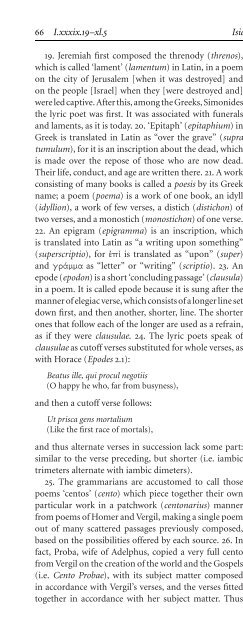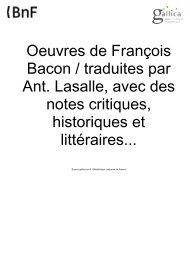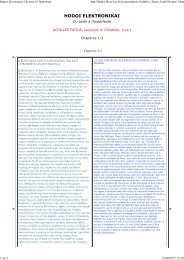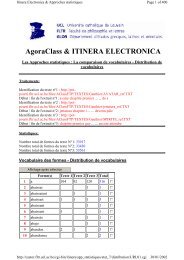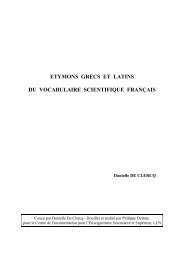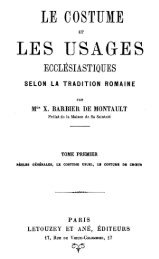The Etymologies of Isidore of Seville - Pot-pourri
The Etymologies of Isidore of Seville - Pot-pourri
The Etymologies of Isidore of Seville - Pot-pourri
Create successful ePaper yourself
Turn your PDF publications into a flip-book with our unique Google optimized e-Paper software.
66 I.xxxix.19–xl.5 <strong>Isidore</strong> <strong>of</strong> <strong>Seville</strong><br />
19. Jeremiah first composed the threnody (threnos),<br />
which is called ‘lament’ (lamentum)inLatin,inapoem<br />
on the city <strong>of</strong> Jerusalem [when it was destroyed] and<br />
on the people [Israel] when they [were destroyed and]<br />
were led captive. After this, among the Greeks, Simonides<br />
the lyric poet was first. It was associated with funerals<br />
and laments, as it is today. 20.‘Epitaph’ (epitaphium)in<br />
Greek is translated in Latin as “over the grave” (supra<br />
tumulum), for it is an inscription about the dead, which<br />
is made over the repose <strong>of</strong> those who are now dead.<br />
<strong>The</strong>ir life, conduct, and age are written there. 21.Awork<br />
consisting <strong>of</strong> many books is called a poesis by its Greek<br />
name; a poem (poema) isawork<strong>of</strong>onebook, an idyll<br />
(idyllion), a work <strong>of</strong> few verses, a distich (distichon) <strong>of</strong><br />
two verses, and a monostich (monostichon)<strong>of</strong>oneverse.<br />
22. Anepigram (epigramma) isaninscription,which<br />
is translated into Latin as “a writing upon something”<br />
(superscriptio), for is translated as “upon” (super)<br />
and as “letter” or “writing” (scriptio). 23. An<br />
epode (epodon)isashort ‘concluding passage’ (clausula)<br />
in a poem. It is called epode because it is sung after the<br />
manner <strong>of</strong> elegiac verse, which consists <strong>of</strong> a longer line set<br />
down first, and then another, shorter, line. <strong>The</strong> shorter<br />
ones that follow each <strong>of</strong> the longer are used as a refrain,<br />
as if they were clausulae. 24. <strong>The</strong>lyricpoets speak <strong>of</strong><br />
clausulae as cut<strong>of</strong>f verses substituted for whole verses, as<br />
with Horace (Epodes 2.1):<br />
Beatus ille, qui procul negotiis<br />
(O happy he who, far from busyness),<br />
and then a cut<strong>of</strong>f verse follows:<br />
Ut prisca gens mortalium<br />
(Like the first race <strong>of</strong> mortals),<br />
and thus alternate verses in succession lack some part:<br />
similar to the verse preceding, but shorter (i.e. iambic<br />
trimeters alternate with iambic dimeters).<br />
25. <strong>The</strong> grammarians are accustomed to call those<br />
poems ‘centos’ (cento) whichpiece together their own<br />
particular work in a patchwork (centonarius) manner<br />
from poems <strong>of</strong> Homer and Vergil, making a single poem<br />
out <strong>of</strong> many scattered passages previously composed,<br />
based on the possibilities <strong>of</strong>fered by each source. 26. In<br />
fact, Proba, wife<strong>of</strong>Adelphus,copiedaveryfullcento<br />
from Vergil on the creation <strong>of</strong> the world and the Gospels<br />
(i.e. Cento Probae), with its subject matter composed<br />
in accordance with Vergil’s verses, and the verses fitted<br />
together in accordance with her subject matter. Thus<br />
also a certain Pomponius, among other compositions <strong>of</strong><br />
his leisure hours, written in his own style, composed his<br />
Tityrus out <strong>of</strong> this same poet, in honor <strong>of</strong> Christ; likewise<br />
he composed a cento from the Aeneid.<br />
xl. <strong>The</strong> fable (De fabula) 1. Poetsnamed‘fables’(fabula)<br />
from ‘speaking’ (fari), because they are not actual<br />
events that took place, but were only invented in words.<br />
<strong>The</strong>se are presented with the intention that the conversation<br />
<strong>of</strong> imaginary dumb animals among themselves may<br />
be recognized as a certain image <strong>of</strong> the life <strong>of</strong> humans.<br />
Alcmeon <strong>of</strong> Croton is said to have been the first to invent<br />
these, and they are called Aesopian, because among the<br />
Phrygians, Aesop was accomplished in this area. 2.And<br />
there are both Aesopian fables and Libystican fables.<br />
<strong>The</strong>y are Aesopian fables when dumb animals, or inanimate<br />
things such as cities, trees, mountains, rocks, and<br />
rivers, are imagined to converse among themselves. But<br />
they are Libystican fables when humans are imagined<br />
as conversing with animals, or animals with humans. 3.<br />
Poets have made up some fables for the sake <strong>of</strong> entertainment,<br />
and expounded others as having to do with the<br />
nature <strong>of</strong> things, and still others as about human morals.<br />
Those made up for the sake <strong>of</strong> entertainment are such<br />
as are commonly told, or that kind that Plautus and<br />
Terence composed. 4. People make up fables about the<br />
nature <strong>of</strong> things, like ‘crooked-limbed Vulcan,’ because<br />
by nature fire is never straight, and like the animal with<br />
three shapes (Lucretius On the Nature <strong>of</strong> Things 5.905):<br />
A lion in front, a dragon in the rear, and in the middle,<br />
the Chimaera itself,<br />
that is, a she-goat. 46 With this, people intend to distinguish<br />
the ages <strong>of</strong> man: the first, adolescence, is ferocious<br />
and bristling, like a lion; the midpart <strong>of</strong> life is the<br />
most lucid, like a she-goat, because she sees most acutely;<br />
then comes old age with its crooked happenstances – the<br />
dragon. 5.Thus also the fable <strong>of</strong> the Hippocentaur, that<br />
is, a human being mixed with a horse, was invented to<br />
express the speedy course <strong>of</strong> human life, because it is<br />
known that a horse is very fast.<br />
46 That is, the middle <strong>of</strong> the creature has the form <strong>of</strong> a shegoat.<br />
Lucretius took the basic form <strong>of</strong> the Chimaera, and hence its<br />
torso, to be a she-goat (capra), from the Greek , “she-goat”<br />
or “the monster Chimaera.” Here and elsewhere <strong>Isidore</strong> uses the<br />
word caprea,regularly meaning “roe-deer,” for “she-goat” (regularly<br />
capra).


